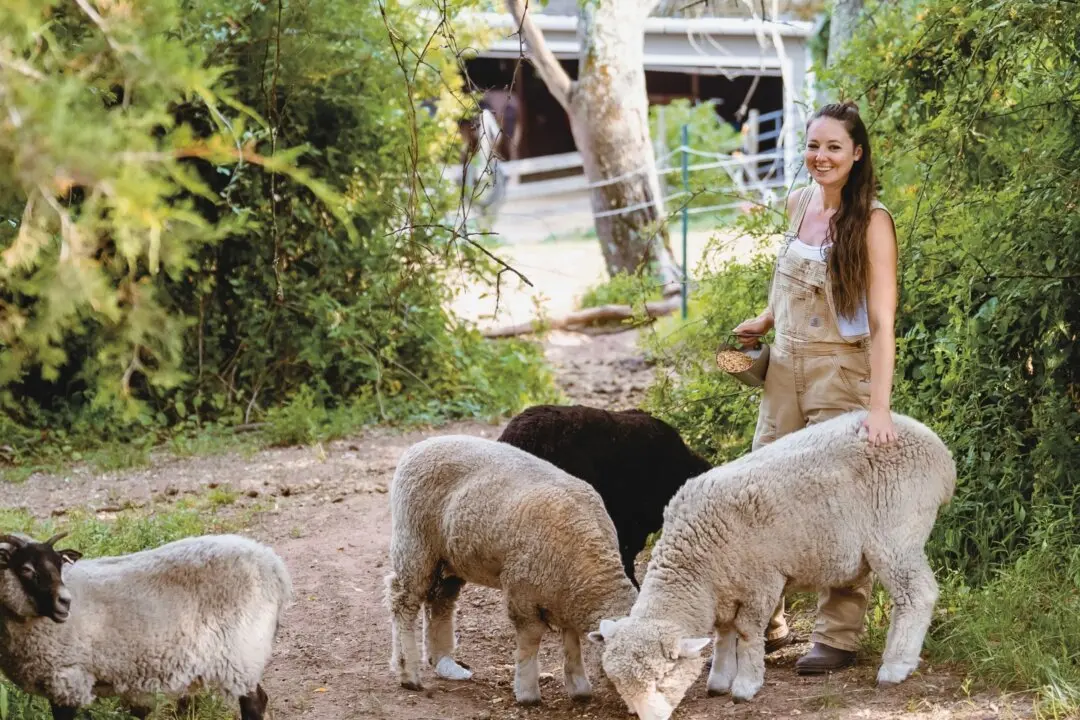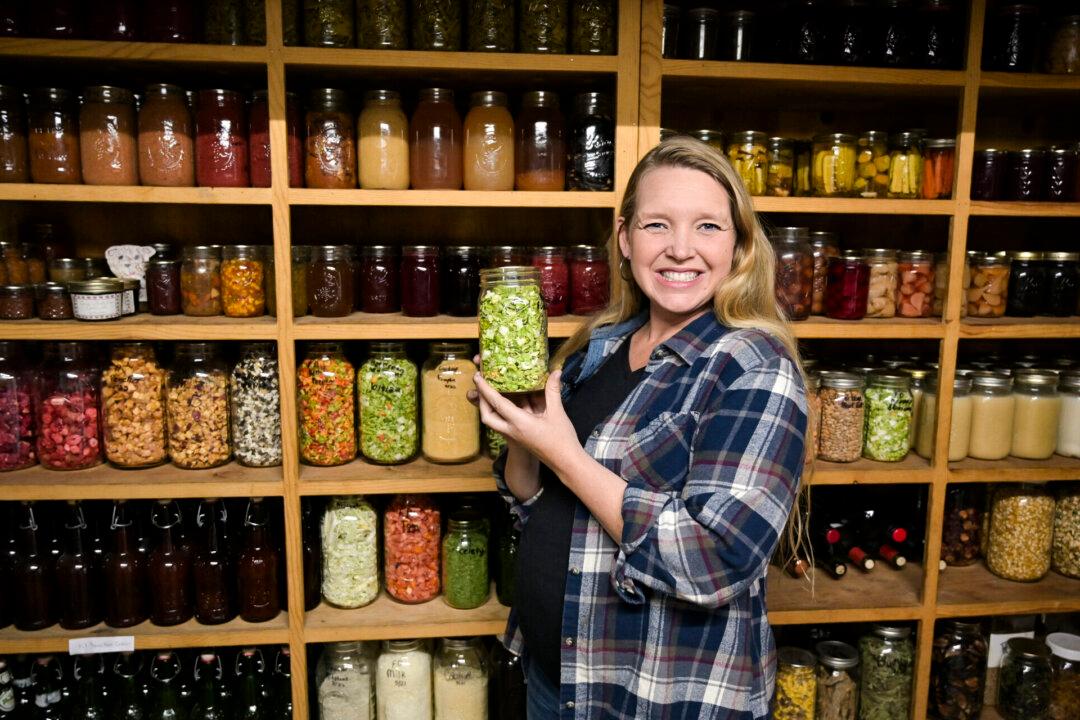Something is always baking in Sue Becker’s kitchen. The aroma of spices, sugar, yeast, and flour hangs in the air. Bread pans, cookie sheets, and muffin tins emerge from their cabinets, ready to begin their day’s work. But there is something different about this kitchen. No matter how hard you look, you won’t find a single bag of store-bought, all-purpose flour. That’s because this author, podcaster, and cooking instructor has milled her own flour, fresh from whole grains, every day for the last 30 years.
Becker began her journey down the fresh flour rabbit hole in 1992, when she came across an interesting article in a medical journal. She’d developed a passion for food microbiology while studying medicine at the University of Georgia. The article traced the decline in Americans’ health back to the adoption of commercially milled white flour in the 1920s.
Wheat kernels are composed of three parts: the bran, germ, and endosperm. Up until the late 19th century, they were usually ground whole by local community mills. Due to the oils, vitamins, and proteins found in the germ and bran, this flour needed to be used quickly, or else it would go rancid. In the 1870s, food scientists discovered that by removing the germ and bran before milling, they could grind the endosperm and create massive quantities of shelf-stable white flour.
But no one realized that by removing the bran and germ, the flour lost its essential nutrients and fiber. As a result, diseases like pellagra, caused by a deficiency of niacin (vitamin B3), began to sweep the country in the 1900s; the connection between the disease and the nutrient deficiency was not understood until the 1930s.
Becker was shocked.
“I grew up Southern, so cooking and baking from scratch was second nature to me, and I always believed in feeding my family real food. But that article was completely mind-blowing. I knew we needed to make a change,” she said.

A Recipe for Success
That same week, Becker bought a grain mill and some whole grain wheat berries, and began to mill her own flour.
“It made perfect sense, because it was both scientifically and biblically correct. Grains are the most nutrient-dense food God has given us. Our daily bread is meant to nourish us completely,” she said.
As a food scientist, and also as a wife and mother of 9 children—7 biological, 2 adopted—Becker was curious to see how this change in her family’s diet would affect their health. The results were better than she imagined.
For her, the health benefits were immediate. “On the first day, my lifelong bowel issues were gone. Within a week, I noticed that my focus had improved and my energy levels were up. Within a month, I noticed that my sugar cravings were gone. My kids stopped getting runny noses and ear infections, and were getting over colds much faster,” Becker said. “Plus, the bread is absolutely delicious.”
It wasn’t long before friends, family, and community members began asking Becker to make bread for them. Motivated by her discoveries and desire to serve her community, Becker and her husband, Brad, started a bakery, The Bread Beckers, out of their garage in 1993.

That same year, The Bread Beckers was invited to a homeschool curriculum trade show to host classes on baking bread from freshly milled flour. The classes’ success, and the demand that followed, forced them to rethink their business strategy.
“I remember saying to my husband: ‘I don’t think I’m supposed to make bread for the entire world. I’m supposed to teach people how to make their own bread.’ God was raising us up to be like Joseph providing grain for his people in a time of famine,” Becker said.
The couple decided to restructure Bread Beckers as a grain co-op that specializes in providing all the tools people would need to bake bread from freshly milled whole grains. This includes the grains themselves, but also grain mills, cookbooks, spices, and bread mixers.
In 1999, The Bread Beckers moved to their current 10,000-square-foot warehouse in Woodstock, Georgia. Today, they are the largest grain packaging and distribution facility in the southeastern United States, and have helped change the diets, and the health, of thousands of people.
Apart from her business’s success and her family’s health journey, Becker is most encouraged by the testimonials she hears from people who made the change to home-milled flour.
She’s heard from people who have recovered from chronic illnesses, from people with celiac disease and gluten sensitivities who enjoy eating bread again, and from parents who see wonderful changes in the health and appetites of their children.
“We call them ‘It’s the Bread’ stories, because … the only thing that changed was the bread they were eating,” said Becker.
Equipment You’ll Need
As daunting as it may seem to mill your own flour, the process itself is actually quite simple. The grain mill is the key to the whole operation. Becker uses an electric Wondermill, which retails for roughly $300 (2025). This mill can process up to 8 cups of grain at a time, and mill almost any type.
A mill is made of three components: the hopper, grinder, and collection bowl. Once poured into the hopper, the grains fall into the electrically powered stainless steel mill heads that grind them into flour. The finished flour then falls into the collection bowl below.
“The Wondermill’s heads are the same kind they use to grind drugs for pharmaceuticals. They’re self-cleaning, so you don’t have to worry about taking your mill apart, and they give you really fine, evenly milled flour,” Becker said.
The NutriMill Classic ($299) is also a popular choice. “You could also buy a traditional hand-cranked stone mill, but it will take much longer to grind than an electric one, which turns a pound of grain into flour in about 30 seconds,” she said.

The other essential element to the home grinding operation are the grains themselves. The Bread Beckers ships whole grains directly to home millers across the United States. They sell alfalfa, buckwheat, oats, rice, corn, spelt, millet, rye, sorghum, beans, wheat, and numerous other grains. The grains are shipped in sealed, 6-gallon food-grade buckets, which weigh out to 42 pounds.
“Those buckets make roughly 53 loaves of bread, and, because they’re whole grains, they will store indefinitely. I’ve still got Y2K wheat hidden away in my pantry,” said Becker.
As for the types of grain one should buy, Becker says it “depends on what you’re baking.” Hard red wheat is good for all-purpose baking, “while soft white wheat is going to be your pastry wheat because it’s softer,” said Becker.
The only other additional piece of kitchen equipment Becker recommends, but doesn’t require, for the home miller, is a good, strong stand mixer. “You need something that will stand up to mixing large batches of dough day after day,” Becker said. She uses an Ankarsrum Original Stand Mixer ($750 in 2025), which is the closest you can get to an industrial-strength mixer.
Milling Your Grains and Baking
The process of milling grains into flour in the comfort of your own kitchen couldn’t be simpler. You simply add your grains to the hopper, turn on the mill, and watch as the flour slides effortlessly down into the collection bowl.
When it comes to measuring, 1 cup of grain makes 1.5 cups of milled flour. Once the flour is milled, it must be used quickly. “The nutrients begin to oxidize and you’ll lose nutritional value,” said Becker.
When the grains are milled, you can begin baking. The beauty of milling your own grains is that very little is needed in terms of adjusting for recipes that use store-bought all-purpose flour. In her cookbook, “The Essential Home-Ground Flour Book,” Becker provides straightforward directions for how to mill your own all-purpose flour.
For yeasted breads, she recommends using freshly milled hard wheat, or a mix of hard wheat with spelt, rye, or Kamut flour.
You do the same for non-yeasted breads like sourdough, but Becker recommends using a mix of milled soft wheat, spelt, or rye. These flours have higher moisture content, which will create a softer, easier-to-eat bread. After making these changes, you can bake as normal. “The only difference is going to be how much better all your baked goods taste,” said Becker.
For beginning home millers and bakers, especially families with picky eaters, Becker recommends keeping things simple to start. Her aforementioned cookbook provides easy, step-by-step recipes for breads, muffins, pancakes, coffee cakes, cookies, and other pastries.
“Find what your family likes and make it for them,” said Becker. “Don’t start with sourdough though. You can build your way up to that, but it’s a little too complicated for starters.”

Home Milling Economics
It’s easy to gawk at the several hundred dollars’ worth of equipment needed to start your home milling operation. However, if you look past the initial investment, establishing a home mill is incredibly economical.
“The bread is so filling and satisfying that I’m not going into the kitchen to snack, which means I’m buying less food, which means less time at the grocery store, and less time cooking,” Becker said. “And, thanks to the health benefits of whole grains, you’re not going to be going to the doctor as much. Think about how much you’re saving in the long run by making this one simple change.”
Basic Freshly Ground Whole-Grain Muffins

- 2 1/4 cups freshly ground hard red wheat, soft white wheat, spelt , or Kamut
- 1 teaspoon baking powder
- 1 teaspoon baking soda
- 1 teaspoon salt
- 1 egg
- 1/2 cup oil
- 1/2 cup liquid honey
- 1 cup buttermilk
- 12-cup muffin pan or 24-cup mini muffin pan, greased or lined with paper liners






